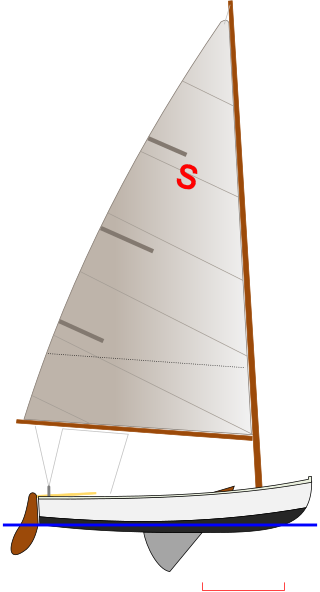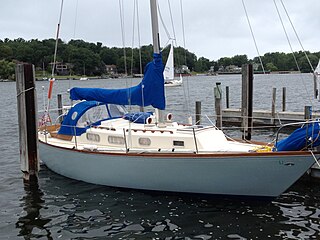Related Research Articles

The Thistle is an American planing sailing dinghy that was designed by Sandy Douglass as a one-design racer and first built in 1945.
The Blue Jay is an American sailing dinghy that was designed by Drake Sparkman of Sparkman & Stephens as a trainer for the Lightning one-design racer. The Blue Jay was first built in 1947.

The Buccaneer 18, also called the Buccaneer dinghy and the Gloucester 18, is an American planing sailing dinghy that was designed in 1966 by Rod Macalpine-Downie and Dick Gibbs as a one-design racer and day sailer. The prototype was first shown in 1967 at Yachting's "One of a Kind" Regatta, in which it placed second.

The Jet 14 is an American sailing dinghy that was designed by Howard Siddons as a one-design racer and first built in 1952.

The Y Flyer is an American sailing dinghy that was designed by Alvin Youngquist in 1938 as a one-design racer and first built in 1941.

The JY15 is an American one-design centerboard dinghy designed by Rod Johnstone in 1989.
The Rhodes 19 is an American trailerable day sailer or sailing dinghy, that was designed by Philip Rhodes as a one-design racer and first built in 1958.

The Penguin is an American sailing dinghy that was designed by Philip Rhodes in 1933 as a one design racer for frostbite racing on the US east coast and first built in 1939.
The Dolphin 24 is an American trailerable sailboat that was designed by William Shaw of Sparkman & Stephens as a Midget Ocean Racing Club (MORC) racer-cruiser and first built in 1959. Shaw had been one of the instigators of the MORC rules. The boat is Sparkman & Stephens' design #1497.

The Snowbird is an American sailboat that was initially designed by Willis Reid as a one design racer and first built in 1921. The boat was re-designed by Edson B. Schock in the 1940s and it became a popular junior class.

The Martin 16 is a Canadian trailerable sailboat, that was designed by Don Martin of Vancouver, British Columbia, specifically as a boat for disabled sailors. It was first built in 1995.

The Tartan 34 C is an American sailboat, that was designed by Sparkman & Stephens and first built in 1968. The boat is Sparkman & Stephens Design Number 1904.

The Mariner 19 is an American trailerable sailboat, that was designed by Philip Rhodes and first built in 1962.
The Pearson Electra is an American trailerable sailboat that was designed by Carl Alberg as a Midget Ocean Racing Club (MORC) racer and first built in 1960.
The Beachcomber 25 is an American trailerable sailboat that was designed by Walter Scott as a cruiser and first built in 1979.
The Interclub Dinghy is an American sailing dinghy that was designed by Sparkman & Stephens as a one-design racer and first built in 1946. It is sailed in frostbite racing on the US east coast, particularly on Long Island Sound. Frostbite races are the series held after the normal sailing season is finished.
The Tech Dinghy is an American sailing dinghy that was designed by George Owen, a professor at Massachusetts Institute of Technology (MIT), as a one-design racer and for sail training. It was first built in 1935.

The Hampton One-Design is an American sailing dinghy that was designed by Vincent Serio as a one-design racer and first built in 1934.
The International 210 is an American sailboat that was designed by Fenwick Williams under the supervision of C. Raymond Hunt as a one design racer and first built in 1946.
The Amphibi-Con 25, often just called the Amphibi-Con, is an American trailerable sailboat that was designed by E. Farnham Butler and Cyrus Hamlin as a racer-cruiser and first built in 1954. The design was one of the first "trailer sailers" and helped popularize this class of boat.
References
- 1 2 3 4 5 6 Browning, Randy (2018). "Geary 18 sailboat specifications and details". sailboatdata.com. Archived from the original on 3 April 2022. Retrieved 2 October 2018.
- 1 2 3 4 5 6 7 8 9 Browning, Randy (2018). "Ted Geary 1885-1960". sailboatdata.com. Archived from the original on 3 April 2022. Retrieved 4 October 2018.
- 1 2 3 4 Sherwood, Richard M.: A Field Guide to Sailboats of North America, Second Edition, pages 90-91. Houghton Mifflin Company, 1994. ISBN 0-395-65239-1
- 1 2 3 4 5 6 The Center for Wooden Boats (2018). "Geary Sailboat Flattie". cwb.org. Archived from the original on 28 February 2019. Retrieved 4 October 2018.
- ↑ Browning, Randy (2018). "Clark Boat Company". sailboatdata.com. Archived from the original on 2 October 2020. Retrieved 4 October 2018.
- ↑ Browning, Randy (2018). "Blanchard Boat Co". sailboatdata.com. Archived from the original on 3 April 2022. Retrieved 4 October 2018.